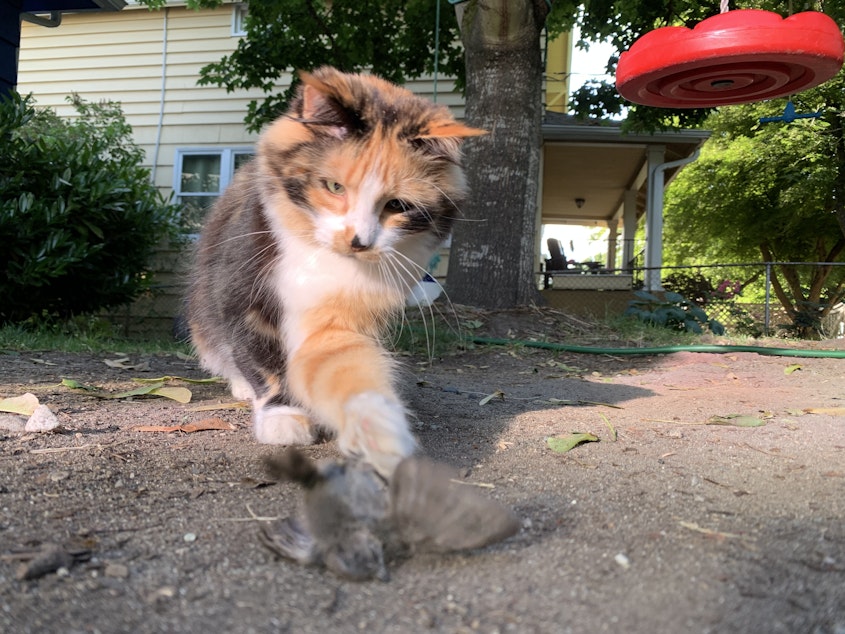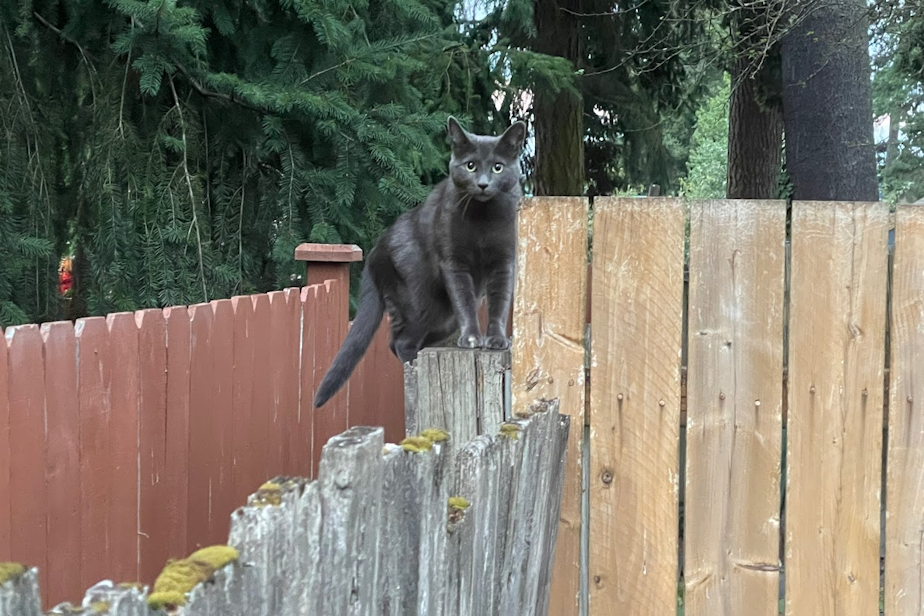Murder kittens: Outdoor cats take heavy toll on wildlife

On a recent morning, patients at a suburban hospital north of Seattle included an orphaned bear cub, a sharp-shinned hawk that had flown into a window, and a barred owl hit by a car.
An exam room at the PAWS wildlife hospital in Lynnwood was silent as veterinarian Nicki Rosenhagen and veterinary technician Ian Gadbaw anesthetized and intubated a female mallard with a fractured hip.
“Wild animals, we’re the ultimate predator, and so they’re not comforted by us talking to them,” Rosenhagen whispered. “So, we try to limit them seeing us and them hearing us as much as possible.”
All sorts of human-introduced hazards can land wild animals in a hospital—or dead. One of the biggest manglers and killers of wildlife is the domesticated cat.
The International Union for Conservation of Nature has listed the domesticated cat as one of the world’s 100 worst invasive species. Biologists have estimated that free-roaming cats kill 1 billion to 4 billion birds and 6 billion to 22 billion small mammals a year in the contiguous United States, more than any other cause of mortality.

Sponsored
“Probably about 60 to 70 percent of what we see are birds,” Rosenhagen said once the mallard was unconscious.
The wildlife hospital currently has about 60 patients. That number shoots up fivefold in the summer as victims of cat attacks, mostly songbirds, pour in.
“If we get 20 patients in a day, we're probably seeing five cat victims pretty easily in the summer,” PAWS wildlife rehabilitation manager Emily Meredith said. “In the winter, not as often, because you don't have those birds nesting on the ground and the babies being so vulnerable.”
Despite the hospital’s best efforts, 80 percent of cat-attack victims brought there do not survive.
“Their injuries are so severe that they are not going to make it, and they usually succumb to those,” Meredith said.
Sponsored
She urged cat owners to keep their pets indoors, for the pets’ sake as well as their potential prey’s.
“Not only are you keeping wildlife safe, you're keeping the cat safe from not being hit by cars, attacked by dogs, injured by coyotes, or any other multitude of problems,” Meredith said.
Meredith said she has had both indoor and outdoor cats as pets over the years.
“All of my cats that were allowed to go outside died prematurely, either hit by a car, killed by coyotes, or killed by a dog,” Meredith said. “They all died like four or five years old, whereas my strictly indoor cats have lived to be 13, 14, 20 years old.”
Sponsored
H
ouse cats are the domesticated descendants of African wildcats, transformed through centuries of breeding into furry companions that humans love to watch cute videos of.
Undeniably adorable in the right setting, cats are elegant assassins of small animals if given the chance, as journalist Egill Bjarnason writes in Hakai Magazine:
Sponsored
How many of these whiskered assassins prowl the shrubs and streets of the Seattle area is unclear.
A good rule of thumb to estimate the number of feral cats in your city, according to Seattle Humane, is to divide the human population by six.
The Humane Society of the United States estimates that 30 to 40 million feral or stray cats live outdoors nationwide, with tens of millions more “owned cats” spending time outdoors.
“Any of them that are outside are a problem, whether they come home at night, or whether they don't,” said University of Washington biologist John Marzluff, who studies urban songbirds. “They're still having an effect there—they're killing animals that you may not see as an owner. They're disrupting the actions of and behaviors of birds that you certainly won't see as an owner, probably, and all of that adds up to disrupting the ecosystem.”
In a scientific paper published in August in the journal Biological Invasions, Marzluff and other biologists called for outdoor cats to be declared an invasive species and their populations controlled—just like if they were feral pigs or giant hornets.
Sponsored
“It would focus attention on cats as a threat to biodiversity and a threat that should be managed, just like we manage all the other threats to biodiversity,” he said.
Alaska, Georgia, Hawaii, New Jersey, and West Virginia list cats as invasive species, and a handful of countries including Australia and New Zealand have spent millions on campaigns to eradicate feral cats before they hunt any more bird or mammal species to extinction.

When it comes to feral cats, those with no owners, Marzluff had a blunt prescription.
“I think we should euthanize them, and that's a hard thing to say. I mean, I'm an animal lover. The last thing I want to do is kill a bunch of animals,” Marzluff said. “It seems inhumane, but to leave these cats out in the wild as well, where their chances of survival are half what they would be in an indoor setting, or in some sort of a more controlled setting, that's inhumane as well.”
“Cats are just being vilified for human encroachment, development, and so on,” said Deborah Sorensen, head of the Alley Cat Project in Seattle. “Habitat is being destroyed.”
In the United States, non-lethal approaches to cat predation are dominant, with groups ranging from pet food companies to humane societies supporting a technique called trap-neuter-release.
“We have a small group of trappers who are the brave people who go out in the cold, in the dark, to set traps for the cats,” Sorensen said.
Her all-volunteer group has cats neutered and quickly returns the ones that cannot be adopted to the great outdoors.
“We also try to set up feeding operations,” Sorensen said, to supplement feral cats’ wild diets.
She agreed that un-neutered outdoor cats’ lives are brutal and short but said that neutering and feeding them greatly improves and lengthens their lives. She said a neutered cat will get in fewer fights and roam across fewer roads.
Wildlife biologists say the trap-neuter-release-feed model does little to limit the fluffy predators’ heavy toll on wildlife.
“Their natural tendency is to be predators, and they're darn good predators, regardless of whether they're full or not,” Marzluff said—something anyone who has seen a cat leap after a bird toy can attest to.
Sorensen said her volunteer group has rescued about 500 feral cats in Seattle in 2022, most of them kittens, with only 90 adults deemed unadoptable and returned to the wild after being neutered.
“We're doing a lot to reduce the impact of free-roaming cats in the environment,” Sorensen said.
She downplayed the differences between feral-cat advocates and those who advocate for wildlife.
“We cat lovers want cats to be safe and indoors. Bird lovers want cats to be not outdoors, so we have common goals,” Sorensen said.
Wildlife biologists say feral-cat advocates are in denial of the scientific consensus on the severe toll cats take on American wildlife.
“I'd like to see managers come up with societally acceptable ways—and that will be a tense discussion—but ways to remove those cats from the wild,” Marzluff said.
Middle ground between the two types of animal lovers can be hard to find.
Some groups have steered clear of the controversy. Glenn Nelson, community director for the bird-conservation group Seattle Audubon Society, said in an email: “While we have a point of view on cats and birds, which you saw on our website, it's not a point of emphasis in our urban conservation."
If you have a cat that lives outdoors, cat experts say winter is the best time to transition it to an indoor life: Cold, wet weather can dampen the allure of the outdoors when a warm, dry bed beckons indoors.
Full disclosure: I got my cats, Lucy Mew and Edward R. Mrrrrow, from the Seattle Animal Shelter, which got them from the Alley Cat Project. They are very good cats, and they are not allowed outdoors.
Correction: An earlier version of the story stated that Seattle Audubon Society declined an interview. A spokesperson provided information to KUOW via email. This post was updated Friday, Dec. 9, at 1:07 p.m. to also add a link to Seattle Audubon Society's official position.
This story is Part 6 of our series on invasive species in Washington state: “KUOW's League of Murder Creatures.”




